The Ohana of Thomas Booth Cummings
The idea for the essay's in this site derived, partly from the Baker genealogy book that was first published in 1999. It was with a notion that I had, after browsing through the Baker publication, that there must be hundreds of stories behind the names and dates that the Bakers so masterfully collected. They were also created, in part, with the inspiration I received from my Uncle "Junior," Joseph Humphreys Cummings Jr. I have only scratched the surface and continue to research the diversity that incorporates the Cummings umbrella of families. I would like to extend my deep appreciation to Harold Prados for his gracious collaborations and valuable research that he has put into the Cummings genealogy. Also to Thomas "Tommy' Cummings Jr, and his sister Patricia Solomon for their contributions. Thanks to Kalei Kaawalauole for his valuable help on translations. Thank you to Mark Miller for his collaborative efforts.
I would like to extend to anyone, with knowledge of stories about our ohana to share them with us. Below is an email that you may use to contact me. Collaboration is the best way to gather more information on our history. There is only so much that can be derived from research. Thank you.
Michael Newtson
maikidagardner@yahoo.com
Content
-
Bristol County Ancestry
-
Arrival at the Sandwich Isles
-
The Makawao Core
-
TB Cummings
-
Makawao 1847 to 1850
-
Life on East Maui
-
The Oldest White Settler in Makawao

Bristol County Ancestry
Recent events have led us to believe that Thomas Booth Cummings was born between 1820 and 1822. Although at present there has been no birth certificate to concretely substantiate his genealogy, the research done in 2008 by David L. Cummings of Cleveland, Tennessee found significant coincidences in the family of Phillip Cummings of Freetown, Bristol, MA, coupled with familiar naming patterns which warranted further research. David L. Cummings has done remarkable research on our ohana and the similar given names between Thomas Booth Cummings children and his ancestral parents, grandparents, uncles, aunts and siblings is nothing short of astonishing. Most, if not all of his relatives hailed from Bristol County, MA. Many from the townships of Freetown, Dartmouth, Berkeley , Middleborough and New Bedford. Bristol County is located just south of Norfolk County about 20 miles south of Boston.
****** Thomas Booth Cummings is part of the seventh (7) generation within the line of Phillip¹ Cummings born 1630, all subsequent generations derived in Hawai'i would count on from that point.
The Information about TB Cummings genealogy, pre-Hawai'i, was sent to me by Tommy Cummings and Patricia Solomon. It has become invaluable to the history of our family.
Freetown
Freetown was first settled by the English on April 2, 1659 on the banks of the Assonet River, when the areas of Assonet and Fall River were purchased for 20 coats, two rugs, two iron pots, two kettles, one little kettle, eight pairs of shoes, six pairs of stockings, one dozen hoes, one dozen hatchets, and two yards of broadcloth from the Wampanoag Indians in an exchange known as Ye Freemen's Purchase. Its population slowly grew, and it existed as a Proprietary settlement until it was officially incorporated in July 1683. It remained a part of Plymouth Colony until that colony merged with the Massachusetts Bay Colony in 1685. The town was the fifth municipal corporation established in Bristol County. Dartmouth was first settled in 1650 and was officially incorporated in 1664. Dartmouth's history was that of an agricultural and seafaring community, but during the late 19th century its coastline became a resort area for the wealthy members of New England society.
New Bedford
New Bedford is nicknamed "The Whaling City" because during the 19th century, the city was one of the most important, if not the most important, whaling ports in the world, along with Nantucket, Massachusetts and New London, Connecticut. The city, along with Fall River and Taunton, make up the three largest cities in the South Coast region of Massachusetts.
Dartmouth
It was named for the town of Dartmouth, Devon, England, from where the Puritans originally intended to depart for America. The land was purchased with trading goods from the Wampanoag chiefs Massasoit and Wamsutta by elders of the Plymouth Colony; reportedly thirty yards of cloth, eight moose skins, fifteen axes, fifteen hoes, fifteen pairs of shoes, one iron pot, and ten shillings' worth of assorted goods.
Berkeley
The present town of Berkeley, then belonging to the neighboring towns of Dighton and Taunton, was first settled in 1638. It was officially incorporated as a separate town in 1735. The town was named for the philosopher and bishop George Berkeley (1685-1753), who lived in Newport, Rhode Island from 1728 to 1731. The change in the spelling to "Berkeley" was likely due to the carelessness of the engrossing clerk of the Massachusetts General Court.
Middleborough
The town was first settled by Europeans in 1661 as Nemasket, later changed to Middlebury, and officially incorporated as Middleborough in 1669. The name Nemasket came from a Native American settlement along the small river that now bears the same name. Nemasket may have meant "place of fish", due to the large amount of herring that migrate up the river each spring.
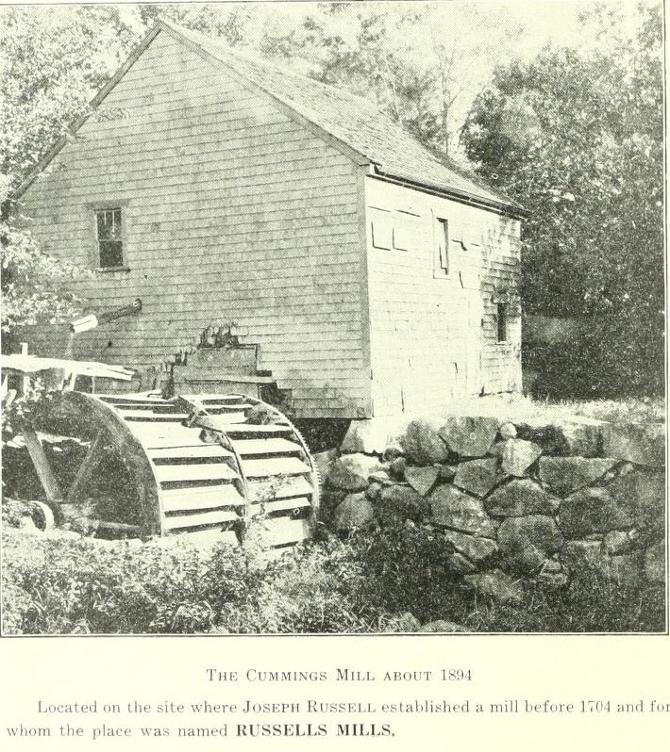
Naming Patterns
One of the sources that led researchers to Thomas' ancestry, pre-Hawai'i, was naming patterns. These patterns can be expressed over generations helping to pinpoint lost ancestry. With the names of his Siblings, Uncles, Aunts, Parents, and Grandparents names being compared to the names of his children, the resulting naming pattern was discovered, helping to further uncover his ancestry.
- Thomas Booth Cummings.................Thomas Booth (his uncle)
- Caroline (daughter)........................Caroline E. Cummings (his sister)
- William (son)................................William E. Cummings (his brother);William Cummings (his father)
- Thomas (son)................................Thomas Booth (his uncle)
- Amy (daughter).............................Amy [Alma] Cummings]; (his sister) Amy [Alma] (his Maternal Grandmother)
- Jonah Booth (son)..........................Mothers maiden name
- Joseph Elijah (son)........................Joseph Cummings (his brother); Elijah Booth (his uncle)
- Parker (son).................................Parker Cummings (his uncle)
- Hannah Rachel (daughter)................Hannah Booth (his sister); Rachel (his sister)
Thomas Booth Cummings Paternal Ancestral Line [1630-1793]
Phillip¹ Cummings
Phillip¹ Cummings, (TB’s 4th Great Grandfather), the American progenitor of the Cummings family of Dartmouth, Massachusetts, was an early settler of Portsmouth, Rhode Island who moved to Dartmouth about 1686. Phillip Cummings bought land in Dartmouth, in June 1687 and was Constable. As a result of his refusal to collect certain taxes during his term as Constable, he was imprisoned in 1704 He died in prison in 1707 and was considered a martyr. It has always been considered that our family may have been linked, as most Cummings in America are, to Isaac Cummings the first known Cummings who settled in Topsfield Massachusetts. Phillip Cummings (1660-1707) is mentioned in The Cummings Memorial: A genealogical history of the descendants of Isaac Cummings , listed under "Families whose relations are untraced." I have traced back from Phillip to Isaac Cummings supposed arrival and have found no connection, making it entirely possible that Phillip Cummings migrated to America on his own.
Early Dartmouth, Mass.
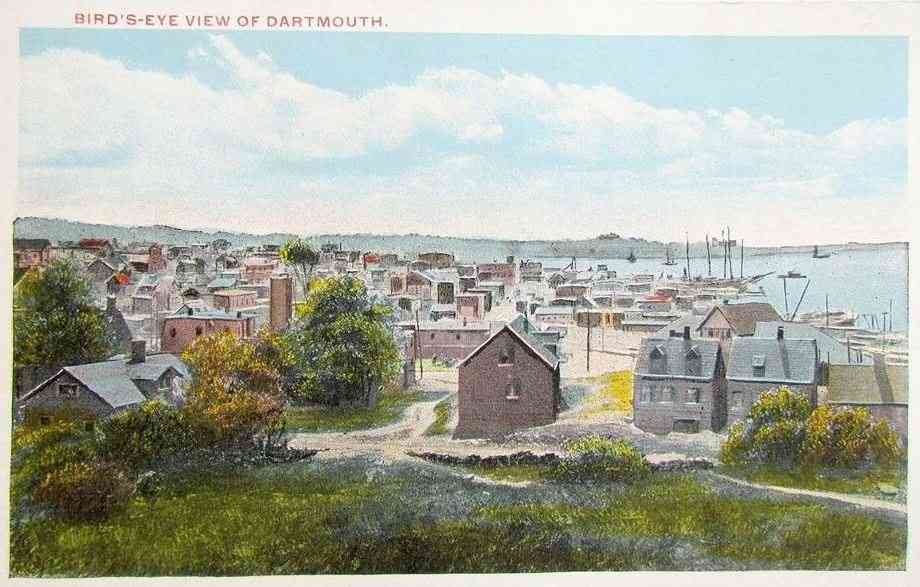
Below: Philip Cummings built this home in 1702 at 397 Old Westport Road in Dartmouth, MA.
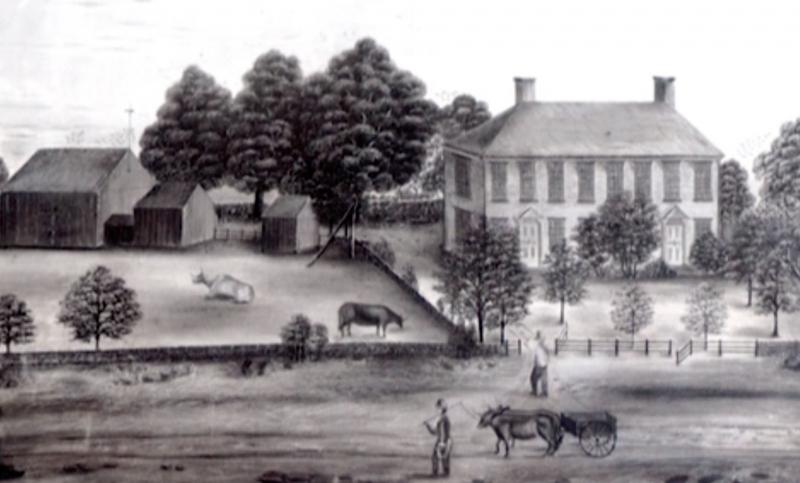
Below: The House still stands today as a Museum
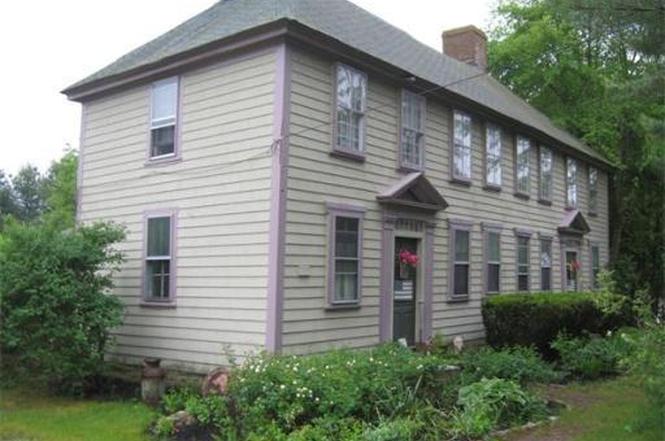
John 2 Cummings (Phillip¹)
John Cummings was born May 14, 1691, probably in Dartmouth Massachusetts. He married (1) Sarah Bragg and (2) Martha Robinson. His Children
- John Cummings Jr., born October 15, 1714
- Benjamin Cummings, born 1716
- Elizabeth Cummings, married Lewis Horton July 23, 1750 at Swansea, Massachusetts
John 3 Cummings (John 2, Phillip 1)
Born 15 October 1714 at Swansea, MA, Married Hannah, Died after 14 September 1790
- Dillilies Cummings, born 19 March 1733/6
- Lovit Cummings, born 8 June 1736, married Isabella Perry
- Alanson Cummings, born 18 June 1738
- Sarah Cummings, born 18 March 1739/40; married Stephen Eddy 4 March 1756 at Swansea, MA
- John Cummings, born say 1740; married Martha Perry 13 December 1764
- Martha Cummings, born say 1756; married William Rider Jr. 7 November 1776
- Hannah Cummings, born say 1758; married Thurston Rider 20 December 1778
- Benjamin Cummings, born November 1750; died August 1831; married Mehitable Rider 10 January 1780
Alanson 4 Cummings (John 3, John 2 Phillip¹)
Born, 18 June 1738 at Dighton and died at Freetown, 22 Feb.1830. Married Drucilla Chase at Freetown, 2 April 1761. Alanson and Drucilla are buried at Chace Cemetery in Freetown, MA.
- Phillip born at Freetown, Ma. 14 April 1768, Married Keturah Booth
- Jael Cummings, born probably at Freetown or Dartmouth say 1773, married Chloe Chase.
- Sarah Cummings, born Dartmouth 30 June 1775, married Dudley Hatheway, Jr.
- Alanson Cummings. Born at Freetown, MA abt. 1780; Married [1] Abigail [Briggs] French and [2] Rosemary
- Sylvester Cummings, Born Freetown, MA 2 January 1782, Married Jemima Newell
Phillip 5 Cummings (Alanson 4, John 3, John 2,Phillip 1)
Born, 14 April 1768, probably at Freetown; married Keturah Booth at Freetown, 9 November 1788 at Dartmouth. She was born, 3 May 1769 at Dartmouth, the daughter of Anthony and Rachel (Parker) Booth. Keturah died at Freetown 17, July 1849, and Phillip died 14 August 1851. Both are buried at Chace Cemetery, Freetown, MA
The Children of Phillip and Keturah
- George Cummings, born 8 May 1789, married (1) Thankful Ashley and (2) Lucy Ashley, sister of Thankful. Their 4th child Jason Cummings married his first cousin Almy Cummings as his second wife
- Betsey Cummings, born 2 July 1791, married David Durfee Chase.
- William Cummings, born 29 April 1793, married Mary "Polly" (Booth) Pierce as her second husband.
- Drucilla Cummings, b. 9 December 1795, married Samuel Robbins, Jr.
- Sylvester Cummings, born 2 May 1798, married Hannah Fuller.
- Mary "Polly" Cummings, born 2 July 1800.
- Sally Cummings, born 30 June 1802.
- Seth Cummings, born 14 March 1805, married Almeda Holloway.
- Jason Cummings, born 24 March 1808, died 26 May 1813.
- Parker Cummings, born 19 February 1812, married (1). Elizabeth H. Lawrence ;(2) the widow Eleanor Bennett, (3) Almira (Pittsley) Allen.
William6 Cummings (Phillip 5, Alanson 4, John 3, John 2, Phillip 1)
Born 29 April 1793 in Bristol, MA, son of Phillip and Keturah (Booth) Cummings. He married 2 August 1812 (int.) at Dartmouth Mary "Polly" (Booth) Pierce. She was the daughter of Stoughton and Almy/Amy (Allen) Booth, born 21 March 1786 at New Bedford, Bristol, MA. Mary Booth had married (1) William Pierce at New Bedford, 17 July 1806.They had one daughter Mary Pierce born 1807, and William Pierce died shortly before 24 April 1809 when appraisers of his estate were appointed by the probate court. William Cummings died at Freetown, between 8 April 1859 (will) and 6 May 1859 (executrix appointed). William asked to be buried at the Burden or Borden Burying Ground (perhaps an older name for the Chace Cemetery). Mary died at Dartmouth 10 December 1868 The 1850 U.S. Census for Dartmouth shows William, aged 57, a farmer, with wife Mary, aged 60, daughter Caroline Russell, aged 21, and grandsons John T. Russell, aged 2 and Francis H. Coombs, aged 16. She has not been located in the 1860 U.S. Census.
The Children of William and Mary
- Mary Pierce, born 15 January 1807.
- Almy Booth Cummings, born 22 February 1813
- Rachel Sullings Cummings, born 24 June 1851
- William G. Cummings, born about 1818
- Daniel H. Cummings, born about 1819
- Thomas Booth Cummings, born 1820-1822
- Benjamin T. Cummings, born 28 April 1823
- Hannah R. Cummings was born 12 September 1827
- Caroline E. Cummings, born about 1828
- Joseph T. Cummings, born 15 January 1831
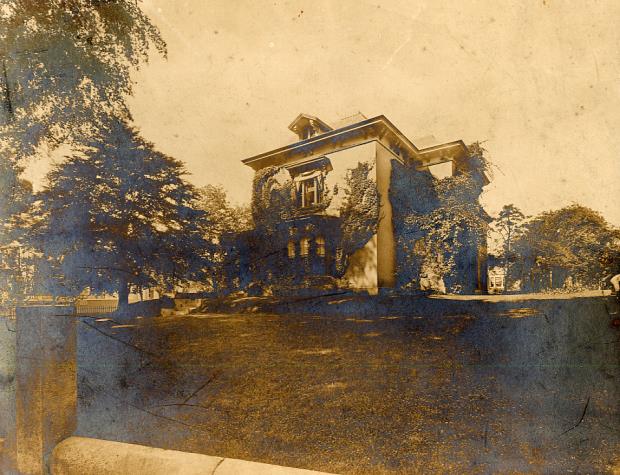
The House of Benjamin T. Cummings (brother of T.B. Cummings)


“Whether Thomas was a mariner, an adventurer, or both is not known" (D L Cummings,2008). What we do know is that he kicked around the Barbary Coast for a while with Henry Lawrence Sheldon before the two decided to seek adventure in the Sandwich Islands. Hopping a whaling ship the SS Montreal out of San Francisco, they arrived in Hawai'i sometime in the summer of 1844.
As some of the information in this site has been gathered from old newspapers contained in the Chronicling America, and Ulukau online sites. One of the first accounts of Thomas Booth Cummings was found in the Hawaiian language newspaper Ka Elele, in February of 1849, listing him as "Toma Kumine" in the eulogy by Rev. J.S. Green about the passing of Cummings first wife Mary McLane Cummings. Another early account was listed in the government sponsored Polynesian on April 28, 1849. It listed Thomas Cummings as a foreign juror for the 2nd circuit court in Lahaina, Maui. After these early listings he was commonly referred to as T.B. Cummings. This reference of "TB" separated him from two other Thomas Cummings that we know of in Hawai'i that shared the same first name. One a former ships captain turned rancher in Waimanalo who left the islands in 1860 for health reasons, and a second that was a lifelong resident of Honolulu.
The Montreal's History
The Montreal was built in 1833 in New York City by C. Bergh & Company. During her lifetime, she sailed on a total of three whaling voyages all out of New Bedford. Her first was from 1850-1853, captained by Frederick L. Fish. Her second was from 1853-1857, captained by Thomas F. Allen. Her third and final voyage was from 1857-1862, captained by Nathaniel W. Sowle. Following her third whalingvoyage, she was sold to New York in 1862 and then to New Zealand in 1863 where she was renamed the City of Newcastle. Prior to these whaling voyages, the Montreal served as a merchant vessel. Second cousins of TB Cummings, William, Benjamin and John Cummings at one time held shares in the Montreal.
The New Zealand Register of ships 1850-1960 records that the City of Newcastle (Montreal) was first sold to owners in Melbourne, Victoria, Australia in 1863, in 1868 she was sold to new owners in Sydney, NSW, Australia and it was not until August 1870 that five new owners in Wellington, New Zealand purchased her and she was registered in Wellington. The ship was used in the Wellington area, she did not come to the Port of Auckland according to the Auckland Registers of vessel arrivals and departures. The ship was wrecked in Cook Strait (between the North and South Islands of New Zealand) on 20th February 1872, at that point she had sailed for 39 years.
A Connection to the Whaling Industry
Benjamin Cummings, (gr.Uncle to Thomas) was born in Dartmouth, Mass., in 1750. He served in several town offices, including surveyor of highways 1784-1815 and selectman from 1798-1808. In addition to his civic duties, he also owned a saw mill and a grist mill, commanded merchant vessels, and operated a general store in partnership with his son, William Cummings (1783-1872). Upon Benjamin's death in 1831, William took his brother, John Cummings (1795-1864), as a partner in the store and called the business William Cummings & Company.
To supplement their mercantile activities, William and John, along with their brother, Benjamin Cummings (1797-1863), invested in whaling vessels through agents such as Gibbs & Jenney of Fairhaven, Mass., and William Gifford and Charles R. Tucker & Company, both of New Bedford, Mass. Benjamin's son, Charles Smith Cummings (1830-1906), formed a partnership with his brother-in-law, Abner R. Tucker (ca. 1818-1884), in 1853. The firm, known as Tucker & Cummings, was active at Dartmouth, Mass., in the grocery trade and in whaling as outfitters and agents. In 1881, Tucker withdrew from the business and his nephew, Benjamin Cummings (b. 1852),
succeeded him in the firm C. S. & B. Cummings of New Bedford, Mass., which withdrew from whaling and concentrated on the grocery trade.Benjamin Tucker Cummings, born in 1834, the son of John Cummings, was also active in whaling, serving as agent through his firm Gifford & Cummings, a partnership with his brother-in-law, Charles H. Gifford. Benjamin died in 1917. His nephew, Lawrence Belding Cummings (1881-1947), wrote an unpublished genealogy of the family just prior to his death.
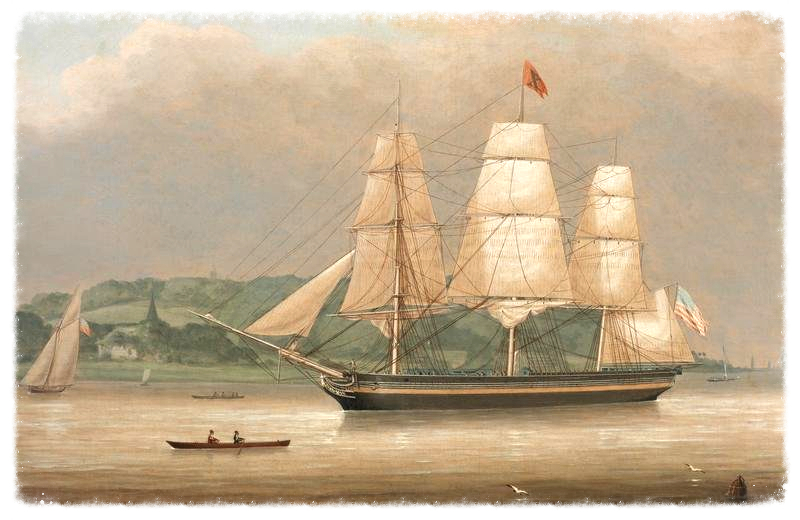
The Ship "Montreal" out of New Bedford
Thomas Booth Cummings arrived in Lahaina sometime around July 24, 1844 aboard the ship Montreal, possibly with Henry Lawrence Sheldon, Capt. Snow Master from San Francisco. Its importance within our genealogy is not overwhelming, however, it does hold some significant in that it is the only vessel mentioned in any of our ancestral history. She did port many times in Lahaina and Honolulu as is recorded in the early newspapers between 1844 and 1850 and intermittently thereafter.
Henry Lawrence Sheldon
“Henry Lawrence Sheldon Born: 1824 in Newport, Rhode Island, Died Nov 16,1883, Kohala, HI. "Great, great grandfather Henry was described as being somewhat bohemian. He was easy going, carefree, literary, artistic kind of guy, who ventured out into the world to seek and write about his adventures. He came to California, wanting to experience the adventure along the Barbary Coast of San Francisco, met Thomas Booth Cummings, from Boston, Mass. both hungry for adventure, in 1844 took a ship from San Francisco to Hawaii. Here's where they found their paradise”(Baker, 2008).
Henry Sheldon, was later to write the first history of Hawaii's newspapers. He also contributed two sons to journalism who were to become printers on native Hawaiian opposition newspapers (Sheldon's wife was Hawaiian). The "bohemian" Sheldon, as Thomas Thrum called him, arrived in Hawai'i from Rhode Island, via the gold fields, and initiated the weekly Honolulu Times. He advocated free trade and speech. He opposed the "detestable machinations of the missionary clique," especially those of Dr. Judd.49 Sheldon insisted he was not against Kamehameha III and certain good religious people—he wryly lumped together the Roman Catholic Priest Father Louis Maigret and Protestant ministers Asa Thurston and Samuel Damon. He proposed, however, that sanitation and medical care for Hawaiians take precedence over attempts to Christianize them. Lacking financial support, Sheldon left town but re-emerged in the employ of King Kamehameha V and Honolulu opposition papers in the 1870s.
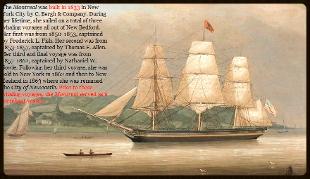
References
Cummings, D. (2008).New Bedford Whaling Museum Research Library Mss 51, sub-group 10,Thomas Booth Cummings Papers, [1 volume]. Ancestry of Thomas Booth Cummings Maritime
New Zealand, (2014).The New Zealand register of ships [1850-1960]. Retrieved from. http://www.maritimenz.govt.nz/default.asp
Baker, B. (2005), Cummings Hawaiian Genealogy, 3rd Edition, Rev. 2005, 226 pp., Vacaville, CA, published by the author.

Change
From the second that fisherman off Kauai's coast mistakenly took Cook's two ships for the floating Islands that Lono had promised to return on, an unforeseen change began. The last vintage of undiscovered land of any size had now been unveiled. Moreover, its strategic emplacement, something its native sons could never comprehend, would set the backdrop for drastic changes, some well-meaning, others insidious in nature.
Before the re-discovery by Cook, the agricultural labor was not onerous. The Maka'ainana were forced to work 6 days in every 14 day period for the King and Konohiki. According to Wienman, (1934).
However, change did come, and it brought with it from other lands the good and the bad. It brought men like John Meeks who first arrived in 1809, eleven years before the missionaries, and captained Kamehameha the Greats Schooner. Meeks worked as a harbor pilot raised cattle and constructed numerous downtown Honolulu structures (Karpiel, 1999). It also brought men like L.L. Torberg who took advantage of Hawaiians in Makawao with crooked land deals. It brought Edwin Miner, who served the Kingdom well as District Justice in Lahaina for many years. Then again, it introduced annexationists like James Blair, Barnum Field, and Alexander Cartwright who were defiant critics of the Monarchy (Karpiel, 1999). Cartwright, was a double bladed sword who cut both ways. His anti-Monarchy views were tempered by his introduction of baseball to the islands and his construction of its first field in Moiilili. The aforementioned instances are included as they pertained to the evolving Kingdom of Hawai'i that TB Cummings entered into on July 24, 1844.
A Core in Makawao
Most of the names that you will find in this section, you will not find in our genealogy book. However, they are important to our history, because they were of even greater importance to TB Cummings. Collectively they share only a footnote in Hawaii's history. In the history of East Maui, they played an important role as innovators in the implementation of agriculture and ranching. The sugar planters and ranchers that followed, owe much of their success to the men who initiated the farming of sugar and wheat and introduced cattle to the upcountry.
William A. McLane
Born in Boston, Mass in 1795, Wm. McLane left home at age 17 according to U.S. Army records he serve 5 years in the United States Army assigned to an artillery unit, including service in the War of 1812, participating in the battle of Plattsburgh. He was discharged March 1, 1817 at Fort Trumbull, Conn.
Arrival on Maui 1822
Mclane, we know, arrived on Maui at least by 1822. The earliest account we have of Mclane on the island is listed in Vol. 2 p. 166 , January 6, 1848 in the Registrar and Testimony of Land Commissions in which is recorded his claim to LCA 3201; Ili Kapalaalaea; Royal Patent 2775, by virtue of receiving the parcel from Puupahoehoe for services rendered in 1822.
It appears William A. McLane was living at the house of Puupahoehoe, in what had become known as the Waikapu Hotel, as late as 1825.
In 1830, McLane was to receive the adjoining property named Awakamanu from Puupahoehoe , which totaled 3.65 acres. This was to be combined with the 1.60 acres known as Kapalaalaea in RP 2775. This was also noted in his testimony in January 6, 1848.
The Poem "Hawaiians' was drafted by Poet George A. Hoag when returning to Spokane, WA in 1923, after spending several months in Hawaii. It decries the sentiment of Hawaiians at the turn of the century, from Hoags point of view.
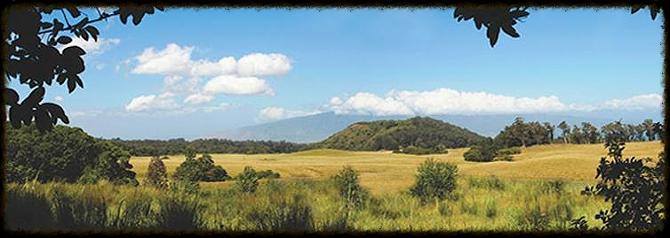
Puu Pi'iholo [center] is a volcanic cinder cone that helped to mark the southeast corner of the McLane/ Miner Plantation
The McLane/ Miner Plantation
McLane and Miner never achieved the monetary success of the sugar planters that were to follow, they did, however, run a successful and profitable operation that paved the way for the enormous successes of the plantations that followed. According to MacLarren, (1995).“Sugar establishments owned by foreigners were in the minority during the 1830’s and were principally in Makawao and Hana. Leasing land at $50 per year for fifty years from Hoapili, in 1838, Edwin Miner and William McLane started a plantation. The governor guaranteed them rights to obtain water for their animals and to hire and house workers free of konohiki demands, and he agreed to build for them a road to the sea for their ox carts. No one could live on the land without the permission of Miner and McLane. In return, Miner and McLane were to obey all laws and construct a school for all people in their employ. McLane and Miner actively grew and manufactured sugar until they were joined by John T. Gower in 1849. All three individuals were also store owners in the Makawao district” ( pps. 42,44).
The Land and agreements are described in the document in the Native Register Volume 2:153-155; 1838; Maly, translator. [See Register Maps Nos. 186 & 603 for reference points]. The agreement was made and signed in Wailuku, on September 10, 1838 by William A. McLane, Edwin Miner, Hoapilikane and witnessed by William Richards and Kanakaole for Kamehameha III. This was the beginning of the first sugar plantation on East Maui. The deal was probably brokered with the help of Rev. Jonathan S. Green. Green was a promoter of experimental agriculture in the upcountry and had positive relationships with Kamehameha III as well as Hoapili, Maui's Governor.
Stipulations
Adding to the agreement the governor agreed to build them a road to the sea for their ox carts. No one could live on the land with out the permission of Miner or McLane. In return, Miner and McLane were to obey all laws and construct a school for all people in their employ . This Plantation became the model for all that followed. The first mill in the area was built immediately, it was located about where St. Joseph's School is located near the intersection of Makawao and Piiholo. There were two parcels to the plantation the largest (380 acres) was located from the intersection of Makawao and Piiholo towards towards the upcountry to the point of Puu Piiholo cone, and stretched between the gulches of Punaokeawe and Alelele. The second parcel stretched south to north along what is Baldwin Ave. today. It totaled 318 acres. In addition to the plantation McLane operated a livestock ranch.
A Description of the McLane/Miner Plantation 1841
In 1840 and 1841, Commander Charles Wilkes of the United States Exploring Expedition, toured the Hawaiian Islands. According the Journal of Hawaiian History, "In April 1841, Wilkes narratives provides readers several descriptions of the lands of the Wailuku and Kula Districts, including the Hamakua-koolau region. Mr. McLane's is the only plantation. It occupies a most delightful situation. His house---and a real Yankeefied look it has, with its red sides and porticoed [porticoes] front, stands in the midst of a Koa grove. Plants bloom in careless profusion about it; the rose bushes grow mostly luxuriantly, forming hedges crowned year around with their rich flowers, filling the air with fragrance; geraniums rival them in numbers and sweetness; well-kept fields of cane extend in front of the house over 100 acres; fences enclose it in part and separate it from verdant pasture ground; corn and pumpkin have their allotted space; clumps of trees here and there resemble orchards; nothing, in short, is wanting but the real apples, pears, peaches, and plums themselves to render the coup d'ceuil as gratifying to the palate as to the eye. Perhaps these will appear in time. McLane’s sugar mill is about a half mile below his house. The sugar here is of excellent quality and one ton per acre is produced" (Wilkes, 1852)
Following in the footsteps of Captains Cook and Vancouver, Charles Willkes, along with his two predecessors, would be considered more of a Geographer than a Sea Captain by today's definition. They not only categorized the sea ways but through their integration with the different cultures they came in contact with they were able to reduce our differences between societies.
Native Hawaiians Early Planters
In East Maui and Makawao about 700 acres of cane were growing in the early 1840's of which 200 acres were Hawaiian owned. Makawao was becoming an agricultural hub for the East Maui area and Hawaiians were actively involved. By the 1850's wheat and barley would become cash crops grown in the upcountry. (RHAS, 1853, p. 37) .
McLane/Miner Partnership Dissolved
McLane and Miner actively grew cane for five years, operating the first plantation and mill in East Maui. On December 9,1843 the partners came to an agreement, whereas Mclane would purchase said interest of Miners share. The agreement is listed in the Mahele Aina Index, Foreign Register, Helu 426. The general precipice is listed below.
Land Grant 00157
Located at the southern portion of the plantation on the map below, this Parcel (370 acres) was where the house and mill were located. The southern upper section of this parcel was used to graze stock. Around the house were several acres of pumpkin, corn, squash, potatoes, and orchards. It was all surrounded by 100 acres of Sugar Cane. South on the property, towards the upland were verdant pasture lands. (Wilkes, 1852). This parcel of land is part of the Piiholo Ranch today, which is owned and operated by Piiholo Investors LL C. Originally the land was part of the Ahupua'a of Makawao in the Moku of Hamakuapoko. The parcel can be seen within its original boundaries in the Hawaii State Archives Registered Maps database under #603; #603 Wide; and #186
Land Grant 00064
Land Grant 00064 is the smaller of the two parcels at 318 acres. From 1847 to 1849, Thomas Booth Cummings leased 75 acres from Wm. A. McLane where he planted sugar and other crops, maybe wheat. (Cummings, 2008). During the same period that Thomas' was farming cane Mclane began selling sections of this parcel to various individuals one of which was Crowningberg. For a while a plantation operated as Dow and Parks grew cane on this land. In The map index of the Hawaii State Archives search Registered Maps for maps #603 Wide; 603; and 186. Map 603 Wide is a very well detailed map drawn by surveyor C.J. Lyons in 1872. It also shows the Cummings, O'Maile, and Kamanoulu grants. In the Screenshot below this parcel is the northern track of land that was used primarily to plant cane.
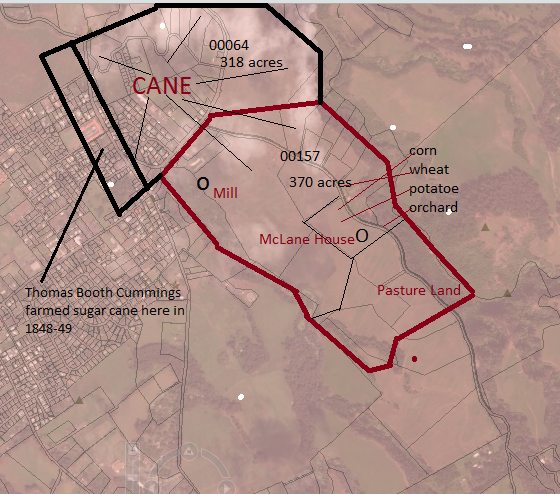
William Archibald McLane Suddenly dies
According to the Polynesian, (1851). “At 2 o’clock noon, October 6, William A. McLane died, (after a distressing illness of only 36 hours,) aged 56 years. Mr. McLane was born in Boston, Mass., August 1795. He went to sea young and after following that mode of life for many years and also serving in the U.S. Army, he came to these islands in a whale ship, and, in 1822, took up his residence on Maui, where he has ever resided up to the time of his death. For the last ten or twelve years he has resided at Makawao, for most of the time as a sugar planter, and here he finished his course, and entered, there is good reason to believe, upon the joys and employments of the heavenly world.
Mr. McLane was remarkable for his amiable and with a guileless disposition, and for his with fervent piety and faithfulness in all the relations of life. He was charitable to the poor, and a friend to the needy; he was a sincere friend to the Hawaiian race, and was ever ready to aid and advise them for their good. His memory is precious. “Let me die the death of the righteous, and let my last end be like his” (p. 86). McLane had no biological connection to the ohana, however, his wife O'Maile, and his stepdaughter Mary, (O'Maile's younger sister), are the originalmatriarchs of the Dutro and Sheldon families.
References
Karpiel, J. (1999). A multinational fraternity: Freemasonry in Hawaii, 1843-1905, The journal of Hawaiian history, (Vol. 34, Ch. 9). Retrieved from. http://evols.library.manoa.hawaii.edu/handle/10524/9
Mahele Aina Index, (1838). Native register, [vol. 2, pps. 153-155]. Maly, translator.Retrieved from.http://www.papakilodatabase.com/main/documentdisplay.php? id=39652&history=so:7,8,9,10,11,12|q:miner%20helu%20426|r:1|s:bestmatch|o:10&s=source
Mahele Aina Index, (1843). Foreign register, helu 426. Retrieved from. http://www.papakilodatabase.com/
MacLennan, C. A. (1995) Foundations of Sugar's Power: Early Maui Plantations, 1840-1860. The journal of Hawaiian history. (vol. 29, Ch. 2). Retrieved from. http://evols.library.manoa.hawaii.edu/handle/10524/9
The Polynesian, (1851). At Makawao, East Maui, (p. 86). [image 2]. obituaries.Retrieved from. http://chroniclingamerica.loc.gov/
Wilkes, C. (1852).Narrative of the United States exploring expedition, (vol. 2). London, England: Ingram, Cooke & Co.Retrieved from.http://books.google.com/books?
Transactions of the Royal Hawaiian Agricultural Society,(1853) Vol. No.4, p. 37, Honolulu, HI: Government Press,
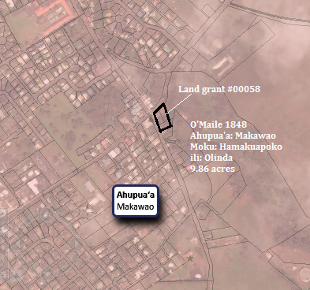
Land Grant 00058
L G 00058 was awarded after O’Maile McLane filed a statement,(document #242), giving a list of persons promised lands in Makawao and showing that the purchase price of $8.73 had been paid in full. On November 17, 1847 a Patent was sent JS Green for Maile by J.P. Judd the Minister of Finance, Kingdom of Hawaii. The land encompassed 9.89 acres was located in the Ahupua’a of Olinda in the District of Hamakuapoko. The recording of this transfer of land is located in the Interior Ministry Book #2; p:180; year: 1847. the land is owned today by J.K.T. Partnership
O'Maile Makaena McLane
We have several mentions of O'Maile in history. This one from JS Green in 1846. According to the Polynesian, (1846). This I say after an acquaintance of some eighteen years. Much of this time I have been her pastor, and it is saying little to say that she is an ornament to her sex, a blessing to her family and neighborhood. Some fourteen years ago she united with the church of Christ at Wailuku, having exhibited for some time uncommonly striking evidence of piety. Since her admission to the church not the shadow of a blot has attached itself to her fair frame; and though severely tried, she has successfully resisted sinful allurements, and proved herself gold seven times purified. I should exceed the limits you can afford me in your paper to speak at all fully of her excellent qualities—of her strong but well directed affections, and of her active and useful habits.
This from the Journals and Letters of Mr. RJ Armstrong.According to Armstrong, (1838), "There are few individuals in the church whose attainments in holiness seem to be of no ordinary stamp.Among these are our excellent Bartimeus and the wife of Mr. McLane, n Bostonian, a member of our church and a good man. This woman is marked for her good sense, humble walk, and untiring zeal, and unwavering constancy. Mrs. Armstrong has often told me that she exceeds any one in prayer she has ever hear,d. She is a great comfort, as well as a great help to us. I am always sure of one attentive hearer and one ready for every good work"(p. 168).
Edwin Miner
Edwin Miner's role in the Life of TB Cummings was somewhat minor. however, he did give him the opportunity for civic duty. It is recorded in many of the early issues of the Polynesian that Thomas served in Miners court in the foreign jury pool. It is probable that Thomas was a friend of Miners oldest son George who was born about the same time as Thomas. Miner was also regarded as one who helped the Hawaiians. It is stated no better than in his obituary, as what type of individual Edwin Miner was recorded by the Polynesian, (1860). "Edwin Miner, of Makawao, Maui, who died on the 4th June, had resided on these islands at least between twenty and thirty years, and, if our memory serve us, even longer than the latter term. He was entirely identified with the country, and one of those to whose memory the country owes a debt of gratitude. In partnership with the late Mr. McLean, he owned one of the, first sugar plantations upon the island, and, instigated thereto, no doubt, by the example by them set, some of the most flourishing sugar growers on the group are now prosecuting their lucrative business in the immediate vicinity of of what was the McLean (McLane) and Miner property. For many years past Mr. Miner has held the post of District Justice, and his constant efforts to see the rights of all equally respected, and his desire to prevent litigation and settle disputes amicably, are acknowledged by all who lived in that part of the country. The deceased gentleman, who had been sick for some three or four months, was a native of England, fifty-five years of age, and left a family, the issue of his marriage with a native of these islands. "We, in common with all who have enjoyed his hospitality, warmed with his humor, and admired his love of the country and people of his adoption, can never forget the qualities that made him a man of mark in his own district and all those surrounding districts in which he was known and his influence was felt.
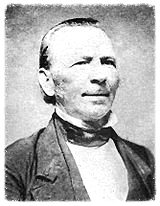
Jonathan Smith Green
J.S. Green played a significant role in our family's history. He was cast as a mentor for Mary Cummings as mentioned in his eulogy delivered at her funeral in Jan. 1849. He was probably the main religious influence on our family. Although there is no marriage document of the union between Mary and Thomas B. Cummings, if there were a ceremony it was more than likely performed by Green. This would also be the case for the marriage of Thomas and Kahale. Green performed the weddings between WH Cummings and Clarissa Jackson and Thomas Cummings and Amorette King.
It's important to mention that because of Green's stable relationship with Kamehameha III, and with the kings cooperation, Green was able to introduced many new agricultural concepts that opened up the Hamakuapoko region to an awry of different crops, including sugarcane and wheat. TB Cummings arrived at Hamakuapoko around 1844. This would have placed him in a time slot where Greens influence would have had an affect on his life. It seems that Greens influences probably factored in to his early years when he was primarily a sugar planter and wheat farmer. Most, if not all of the agriculture in this area, as highly in influenced by JS Green.
Green born December 20, 1796, arrived with the third company of Calvinist Missionaries on board the Parthian on March 30, 1828. From the start of his service it was apparent that this Reverend was cut from a different cloth. Green, in addition to his invocation, was an accomplished Architect, and a Master Carpenter who designed and built the girls seminary at Wailuku in the late 1830's. Green was also instrumental, because of his influence with Kamehameha III and Hoapilikane, in McLane and Miner attaining the 1838 lease in Hamakuapoko.
Agricultural Influences
He was a avid promoter of agriculture in the upcountry. He was a leading proponent of wheat farming and his influence spurned growers in Makawao to allot 140 acres for the grain in 1953. The strains came from Australia, Oregon, and California. There were also Hawaiian farmers that became involved with the growing of the grain. The largest in capacity was the ten acres planted by O'Maile McLanes brother Kileapa. But for the lack of seed, it was estimated that as much as 500 acres might have been planted in 1853, with Hawaiians being responsible for 100 acres. He continually stressed the need for the Hawaiians to understand the concept of excess supply as it relates to profit. This of course was against the grain of Hawaiian thought, as was the concept of land ownership, however, Green must have known that without the understanding of these concepts, the native would eventually lose the fight to retain their lands and their country as well. He lobbied for the foreigners right towards more opportunities in agriculture as a steady influence and example for Hawaiians to become invested into their lands through agriculture. This became a successful venture in the Makawao area as early as 1850, when Green used his role in the Royal Hawaiian Agriculture Society to promote wheat, corn and cane farming, of which many Hawaiians participated.
His Legacy, His Bias
Green was not without bias towards certain antiquities. He once replied to an article about Wm. McLane's Hawaiian wife O'Maile written in the Polynesian newspaper which mentioned, (1846). "O'Maile McLane's character and deserved reputation for domestic virtues and for making a home is second to none of her white sisters on these Islands." In which Green replied. "In justice to Mrs. McLane, let me say that as to qualifications for making a home, it cannot reasonably be supposed that she possess as much information on dress and domestic arrangements, as much tact and taste in matters of this kind as her white sisters. Think of her parentage, respectable indeed, but heathen" (Editorial page, June 5, 1846). By today's standards that would be considered racist. Green at times was certainly outspoken, especially in defense of New England values. However, there was no doubt that he was quite different than most of his counterparts and this is plausible when examining decisions that he made and his legacy which his children chose to extend.
Green left the American board of Christian Foreign Missions about 1842 in protest of their continuing acceptance of support and money from southern plantation slave owners in the United States. He was the only missionary to promote the idea of invested interest to the Hawaiians, with respect to their lands. He was the only missionary to spend as much, if not substantially more time, instituting agricultural and developmental skills, rather than religious pageantry.
As aptly written by Mabel Clare Craft she states, (1898). "Inquire into the the ancestry of the island millionaires, and you will invariably find a missionary pedigree.The missionaries reared their sons to secular occupations. The records of the Republic show that these, at least, considered themselves bound by no vow of poverty" (Hawaii nei, p. 25).
On January 5, 1878 Rev. Green died; Asenath Green, his second wife, would maintain the church until she died in 1894, and then daughters Mary and Laura continued. His son Joseph Porter Green was born October 30, 1833, served at the church also.
In Comparison
I suppose in that time frame in Hawaii's history, when looking back by today's standards, the bias that went on was hardly questioned. However, if we measure Green's life from start to finish with respect to the Hawaiian race, there was a clear cut effort to introduce, by influence, what he believed, was the key to their success in maintaining control over their island Kingdom. In researching this time period, which has produced a large amount of negative opinion as to the legacy that was left by the Calvinist, and with good reason. I have not encountered anyone associated with the Calvinist missions in Hawaii that promoted such a wide spectrum of ideas directed towards helping Hawaiians as did Jonathan Smith Green.


Patriarch
Our family has had so many interesting stories to tell, that it is almost without end the tales that have accompanied our history for the last 180 years. I have written about many individuals from the different parts of our Ohana. Courageous men such as John G.M. Sheldon, and stately figures as was John Kaneakua. William H. Cummings who possessed an innate ability of knowing when to get into a business situation and when to get out, a quality needed to be a successful entrepreneur, of which he certainly was. Of seven women passionate in their endeavor to teach the students of not one, but several generations. Some so dedicated that even marriage was not part of the plan. The early musicians such as Ernest Kaai whose innovative mind developed the first standards in Hawaiian music. A multi-talented individual who excelled as a ukulele and violin virtuoso, a falsetto vocalist, publisher, composer and the list goes on to infinity. Louise Sheldon whose voice was capable of reaching “B-flat” with relative ease. Andy Cummings had a gift for song writing that few ever matched. Moreover, his vast knowledge of Hawaiian music and its history was never fully acknowledged, but it existed throughout his career. Men like Thomas Cummings who steadily progressed for 30 years at Wailuku Sugar Co. becoming the most versatile employee in its history to that point. And yes indeed, even as ironic as it seems, the antics of Peter Moses Naluai were also a part of this family’s unique history.
TB Cummings was scholarly in the sense that he fused knowledge with common sense and had the wherewith to know that acquaintances in places of power and influence could help at times. It started early on with his passage to Hawai'i with Henry L. Sheldon who would go on have a great deal of influence in Kingdom politics as editor of the "Honolulu Times." It continued on Maui with his personal relationships with Edwin Miner, Wm. A. McLane and the Rev. Jonathan Smith Green. These three men were very influential foreigners in East Maui, at a time when whites were few and far between. He served in Justice Miner's Second Circuit Court at Lahaina.
TB Cummings was primarily a wrangler, a teamster, a man who worked well with stock. From 1855 to 1865 he wrangled for Lot Kapuāiwa, Minister of the Interior, at the time. There is every inclination to believe that he was a man of respect and substance. TB Cummings rubbed shoulders with John Owen Dominis, Ana Keohokalole (Mother of David Kalakaua) and befriended William Humphreys (Uwelealea) as a fellow juror in Miners court. Humphreys would go on to become a Supreme Court clerk. Neither Famous, nor wealthy, Thomas Booth Cummings was able to affect the lives of the primary generations in a vast family.
Wranglers in the upcountry c.1880
Hamakuapoko 1844-1849
What ever adventuresome life Thomas led before his arrival on Maui, or if he remained firm in continuing that lifestyle, we may never know. For on December 4, 1847 his life took on a new direction for he acquires 73 acres of land through a lease with William A. McLane and commits to farming. He had also planted 7 acres of cane on land owned by William Crowningburg. If he was leasing land from McLane in the same area as Crowningburg's land this would have put him at the northern edge of McLane's plantation near the foreigner's church and not far from the Kaluanui mill. (all referenced on Reg.Map 0603 wide). It would have been about this time that a relationship would have started with Mary Makaena McLane, William and O'Maile McLane's daughter. She was actually adopted and was O'Maile's younger sister. It seems to fit that Thomas was getting his economy in order and planning to support his future with a career as a sugar planter.
1849 started as any other that had passed through the upcountry, however, for Thomas B. Cummings as it would be for any young man, would suffer through some personal grief. On January 21, 1849, hardly three weeks into the new year, his wife Mary Cummings would die shortly after giving birth to Daughter Caroline
Mary was thought to be amiable, intelligent, faithful, and exemplary; a blessing to her family and friends during her brief life. This, unfortunately, was just the beginning of a year of unprecedented grief for the McLane family as well. In the spring a son whose name remains unknown passed away. On November 5, 1849 William's eight year old adopted son George succumbed. Then one month later, to the day, an obituary appeared in the Polynesian stating in part."Early yesterday morning O’Maile an adopted daughter, and niece of Mrs. McLane, aged about 10 years, deceased, thus following in one short month her brother George, whose death you recently noticed. All these children died with disease of the lungs."
Thomas, after fore-filling his crop through 1849 sold all of his "right, title and interest" in his property, stating that it included, "all my share of sugar and molasses....7 acres of sugar cane planted by me on land owned by William Crowningburg on the estate of Hailiimaile" delivered through a bill of sale dated November 13, 1849.
Mary Makaena Cummings
Mary Makaena was born on March 4, 1832 in Waikapu, Maui. What we know of Mary’s brief life comes from two obituaries one in Hawaiian the other in English, the eulogy given at her funeral by Reverend Johnathan Green and a mention of her in the Wailuku Girls Catalog and cited in the Hawaiian National Bibliography 1780-1900: 1831-1850.
Her life was clustered with health issues from an early age. Mary’s older sister O’Maile was more like a mother to her then a sister. O’Maile and her husband William McLane adopted Mary at a young age when she was bed ridden much of the time with a sickness that showed no remission until she turned ten years old. With such little information to go on it’s hard to create a timeline that’s filled with many entries. However there are some fas that we can base our family’s first female member and bearer of Caroline Cummings the first child of our Ohana born in Hawai’i. It is safe to say that Mary did not attend the seminary until she was fully recovered from her illness. The school catalogue puts her at the seminary on March 28, 1843 which marks her age at eleven years and 24 days. This would seem an accurate timeline giving her over a year of recovery behind her. From the eulogy we read that “she was known for actions beyond compare,” says her husband TB Cummings. It is mentioned that she was a pious soul and “she persevered with her man, who she lived with in goodness and without sickness.” Also commenting during the eulogy Smith mentions that: “She was never one to complain and she did not lack of hope and expectations. Mary seemed to be the perfect product of what Green was trying to achieve with his push towards educating women. Mary seemed bright and probably excelled at school and her days at the seminary must have been successful. From the eulogy we gather that she was quite well known as they were immediately informed of her passing. Green describes the mood at the seminary by stating. “The rain will continue inside the school of my women” (Green, 1849).
Here is a very interesting note that I discovered on the Wailuku Girls Seminary catalog. It seems that tucked away all these years in the Hawaiian Mission Children’s Archives is a document called the Atlas of Sacred Geography. It is a collection of 5 engraved maps, including 4 folding maps of Lahainaluna dated 1843. As stated in the Hawaiian National Bibliography. “This atlas was issued without a title or any printed text. The caption title above appears as a contemporary inscription on a copy in the HMCS Archives” (Judd and Bell p. 603). And this is where Mary Makalena come in. “Another copy in the same collection has a penciled presentation inscription dated March 28, 1843” (Judd and Bell p. 603). It states, “From Lorrin Andrews to Makalena, who was a student at the school at the time” (Judd and Bell p. 603). This is a little more information to confirm Mary’s childhood. This document seals any doubt that she was a student at the seminary, given the fact that Andrews and Smith both withdrew from the Congregationalist Church and were good friends on Maui for many years.
The Mystery of Humphreys
In receiving the information about Thomas Cummings pre-Hawaii, it did much to clear up the assumptions we were forced to make. However, ironically it left one question still unanswered. Where did the name Humphreys come from? The researchers admittedly had no answer for the name “Humphreys”. They had based their information on name associations and were successful. However still no answer for the famous middle name that followed for generations. My Grandfather Joseph Humphreys Cummings and his youngest son, my uncle Joseph Humphreys Cummings Jrwere recipients of this namesakes. I think we now have the answer. However, I must admit that it was always right there in front of me, yet in a subtle way.
First of all, whenever you solve a bit of a mystery like this it gives you a feeling of accomplishment because in research there are more dead ends than clear paths to the answer. However, when you discover something or someone, in this case William Humphreys Cummings namesake, that exemplifies an individual who was a true Hawaiian Patriot, in every sense of the word, and who gave so much of himself towards the moralities of the Hawaiian people, you can understand why Thomas B Cummings chose to name his first born son after William Humphreys. I believe Thomas Cummings met William Humphreys, whose Hawaiian name was “Uwelealea,” sometime between 1848 and 1849. The first record of both men together is from the newspaper posting in the Polynesian, page 6, October 20, 1849, listing the foreign jury pool for the Circuit Court in Lahaina. There were three more instances of the men serving together as jurors for 1849. Then no more listings for Humphreys on Maui. This coincides with his residency in Honolulu where for the better part of the next ten years he performed the duties of a clerk for the Kingdom of Hawaii’s Supreme Court. Take note of the time frame in which Thomas becomes acquainted with Humphreys. It is less than a year since the death of his wife Mary.
William Humphreys, as you will come find, was a very inspiring individual. His influence, I believe, could have been very imposing to Thomas at a vulnerable time. “Uwelealea” was elected to the Legislative Assembly as a Representative from Maui in 1864. That is how his name appeared on the roster (Silva and Fernandez, 2006). It was a few years after this that Humphreys was to start on a journey to better the lives of those stricken with Hansen’s disease on Kalawao, Molokai. According to Silva and Fernandez, (2006). “In September of 1867, he wrote a letter to Nupepa Kuokoa, describing his stay at the "Halemai Lepera" or Leprosy Hospital at Kalihi-Kai. He signed it W. H. Uwelealea. He is known, however, in Board of Health records, and thus in histories, as William Humphreys. Uwelealea, as we shall see, was a talented writer in Hawaiian and a leader of two rebellions against the administration of the settlement. He later became an administrator of the settlement himself” (p. 85). This is referring to the settlement of Kalawao on Molokai, of which Humphreys would become entwined in history with. William Humphreys was outspoken against many indignities, one of which was the constant reigning in of Hawaiians with leprosy, while the complete overlook of whites with the disease. He wrote about the double standard saying” All should be taken who have [the disease] a little or a lot, it is not pono to leave a fruit to mature, lest it fall, and seedlings grow” (p. 85). Silva, (2006). “Although Uwelealea here justifies the law, he cannot help but notice and protest that Kanaka Maoli seem to be the targets of the segregation, and haole seem to be exempt. A year after his first letter, Uwelealea wrote another, which described life in Kalawao. It appears to reinforce Ethel Damon's suspicion, as described in Siloama: The Church of the Healing Spring that patients may have been prevented from exchanging letters with their families and friends, and so the newspapers provided a way for patients to provide news to them. Uwelealea then reports that the patients are struggling with the pain of their disease, and that it is heartbreaking to witness the sores and redness of the skin, and especially the loss of fingertips. He never, however, uses any language similar to the Western doctors' description of the disease as repulsive or ugly.Instead he prays for better treatment for the patients. His main point in the letter is to reassure others that Kalawao is a livable place, but one that is permeated with sadness” (p. 87). From this point on William Humphreys dedicates his life to improving conditions at Kalawao. He offers himself up as a teacher, helps the citizens in organizing politically and assists in the starting of a church. What this man did was bring a group of outcast disease ridden individuals back into the human race and offer them hope. In turn their upwelling from his assistance is evident in his next letter published in the Kuakoa, on December 16, 1868. Silva, (2006). “ Their love of their people/nation has been constantly reawakened because of our frequent meetings . . . They have recently elected spokesmen for themselves . . . they are 15 special men, who love their people, and they are called "The Committee of Fifteen of the Chinese Disease Patients of Kalawao," and in all the meetings of the 15 committee, it has been agreed that the administrator and the deputy head as well as the head sheriff of all the patients may attend all the meetings that the 15 Committee hold, and through this wise deed of theirs, life is unified and pleasant, and prosperous” (p. 87). In all the reading and researching I have done over the years, I believe William Uwelealea Humphreys is the first Hawaiian that I have researched that used the media to his advantage, in a deep and personal manner. In this case it was to publicize the horrific conditions on the peninsula. He wrote many articles in Kuakoa depicting Kalawao, both the good aspects and terrible conditions alike. Silva, (2006) “However, his love for his people led him into conflict with the administrators of the settlement. As William Humphreys, he stands out as one of the native leaders whose stories Pennie Moblo documented. He was a popular leader appointed against the will of Honolulu administrators under threat of renewed disorder. since the white members of the Board of Health felt no Hawaiian had the mental capacity to handle financial matters, these were left in the hands of Randolph Meyer, a German planter living above cliffs overlooking the settlement (Moblo, P. p. 694).
Although originally the government envisioned the settlement becoming self-sufficient through farming, after two years, support for the program disappeared. Episodes of food shortages followed and after one such episode in 1870, patients rioted. Humphreys the constable did nothing to stop them. He was arrested for this and sent to Oahu Prison. He was eventually released, but arrested again later during another dispute over the distribution of food. In that case, he and some other men slaughtered a steer and distributed the meat to patients. He was again eventually released, and in 1872 briefly served as superintendent of the settlement. In the winter of 1873 after taking some medicine prescribed by Dr. Trousseau for dropsy, he died. With his death, the patients lost the most eloquent voice of their time” (p. 89). Given the fact that we have associated this man with Thomas Booth Cummings early on in his life. Have found him in articles associating with George Miner, Edwin Miners son, which puts him in the same circles as Thomas, William McLane, and the Miners. We of course also have the name association, which leads me to conclude that William Humphreys, alias “Uwelealea,” is the man for whom Thomas’ son William Humphreys Cummings is named for. This makes Humphreys the only name that did not originate from Thomas’ Bristol County ancestry. Moreover, if it was done from inspiration, Thomas could not have made a better choice.
References
Moblo, P. (2013). Blessed Damien of Moloka'i: The critical analysis of contemporary myth. Retrieved from. http://www.academicroom.com/article/blessed-damien-molokai-critical-analysis- contemporary-myth
Silva, N.K., Fernandez, P. (2006). Hawaiian journal of history. Mai ka 'aina O ka 'eha'eha mai: Testimonies of Hansen's disease patients in Hawai'i, 1866 - 1897 (vol. 40). Retrieved from. http://evols.library.manoa.hawaii.edu/handle/10524/554
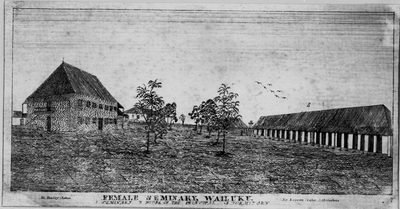
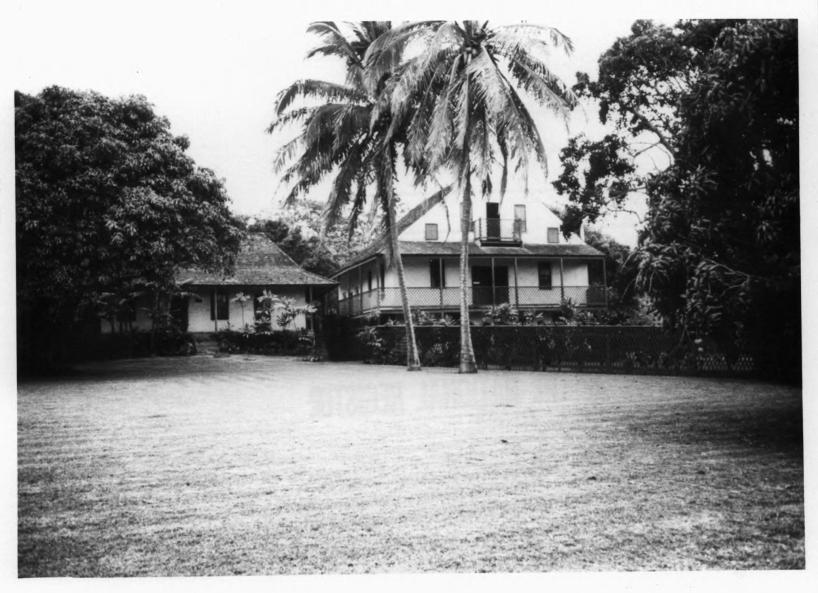
At top a painting of the Wailuku Girls Seminary (c. 1880). Bottom: At the closing of the Seminary it became known as the Bailey House.
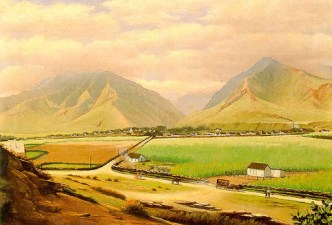
As we associate TB Cummings with Makawao, his later life was spent primarily in Wailuku as a Teamster. Wailuku featured in the in the above painting by Edward Bailey in 1900. In the background is the opening to Iao Valley in the West Maui mountains.

Wheat Farming in the Upcountry
The idea of farming wheat in the upper stretches of Makawao came from the Reverend Jonathan Green, an Agriculturist as well as a Preacher. Green experimented with many different crops, many of which were not quite suited for the semi-tropics of Maui. Greens three land grants, totaling 211 acres, served as a"model farm" for crop experimentation.
In December of 1854 TB Cummings sowed 25 acres of wheat at a rate of about two bushels of seed per acre. Having land rich in soil, the growth of the straw was very thick and even. However, the heads were shorter, and not so well filled. The kernels were lacking in size, about 50% of where it should have been. His yield was under 25 bushels per acre (Gower, 1854, p. 114).
In Makawao, Hailiimaile, Kula, and Hamakualoa an area of not less than 60 square miles there were 40,000 acres adapted to wheat in 1854. Wheat and most of the cereal grains do well in the uplands of Maui, Hawaii and Kauai. These crops were equal in appearance to those in Illinois, Michigan and New York. At elevations between 1,000 and 1,500 feet above sea level wheat has thrived. However it also produced successfully and levels of 10 feet above the sea (Gower, 1854, p. 118).
The wheat experiment was probably TB's last attempt at farming. Ironically it was conflicts between farmers and ranchers that would lead him towards an interest in wrangling stock in one way or another for the next 30 years. As early as 1846 there were reports of numerous cattle owned in the upcountry by foreigners that had been in the habit of trespassing more or less on the farms of the Hawaiians, and creating a lot of damage. Much of the stock roaming aimlessly throughout the upland were Kingdom owned. In 1855 TB Cummings acquired a contract to maintain the kingdoms herd under the tutelage of the Ministry of the Interior. He did this until 1860. He grazed them into the foothills of Haleakala up higher than local farms. When called upon, he would gather the herds and round them into stock pens in Makawao provided by the government. There is very little documentation on his employment from the early 1860's to about 1880, however, we can assume he remained close to stock in one way or another. The ad below appeared in the Polk 1880 Directory, and extends the fact that he did remain in business with stock and teamsters. Interesting note: 93 Market Street is the same business address given in the directory of 1890. So we can assume that he remained in business, most likely with the help of his youngest son Parker, who was employed by the company known as The "Kahalui and Naalaea Express" between 1880 and 1890. The listing is one of the last published accounts of TB Cummings life.
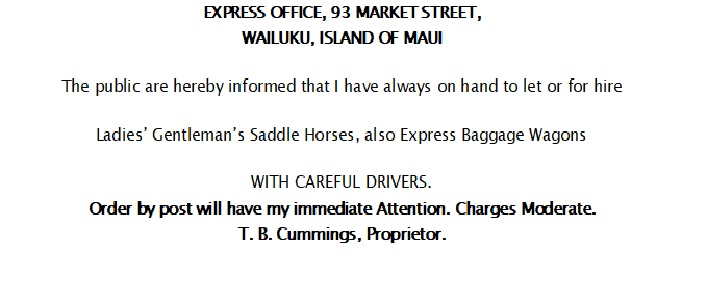
Land Grant # 1692 Specifications
- Grantee: Cummings, Thomas B.
- Year: 1855
- Island: Maui
- Ahupua’a: Makaeha
- District: Kula
- Ili: Pukalani
- Lexicology: Pukalani, heavenly gate
- Original Source: Mahele Book #15
- Source Book: Volume 9
- pps. 95-96
- LG Reel #3, 00862-00863.tif
- Acreage: 100 Acres
- Quadrangle: 50-05
- North 190,000
- East: 610,000
- Catalog #223.21.00
About the land grant 1672
Thomas acquired 100 acres of land in Pukalani through commutation. Most of these grants purchased in fee simple, a form of property ownership in which the owner has outright and unconditional disposal rights. Land Grant 1672 was originally part of a larger Land Commission Award given to High Chiefess Analea Keohokalole (Mother of David Kalakaua)at the Mahele but sectioned and surrendered to five individuals in lieu of commutation,( an exchange orsubstitution,e.g.the substitution of one kind of payment for another). Royal Patent Grants 1203 to Nuole, 1672 to T.B. Cummings, 1694 to S.N. Stone, 1695 to R.P. Bracey, and 1988 to Chas. Barstow, all sections fell under the TMK 2309, and were located in Pukalani "Hill of the Heavens." Being in royalty you can expect some benefit when it came to the Mahele, the higher up the food chain the better the benefits. Analea Keohokalole was no exception she totaled 25 Royal Patents totaling over 10,000 acres. She sold most of her holdings until her death in 1867.
Ranching 1856 to 1860
Correspondence, through letters and invoices, contained in the archives at the Bishop Museum, ties TB Cummings to the Ministry of the Interior as a cattle rancher, between the years 1856 and 1860. The correspondence is between Thomas and Lot Kupuaiwa, Minister of the Interior and is of an array of subjects from rounding up the cattle which at times were allowed to roam the crevices of the upcountry, to reporting on the health and weights of the cattle. It stands to reason that after obtaining the 100 acre grant, he would be in position to bid on this type of contract with the Ministry. Given the fact that Lot Kupuaiwa did join the Ag. Society around 1852, this would have put Thomas in the right position to submit to ranching for the government. In the 1872 registered map #603, there is citing of what appears to be a cattle pen. It is clearly marked on the map as "Cummings." It would have been located where the Haleakala Hwy and Makawao Ave. intersect today. Below is a cut out of that cattle pen from registered map #603.

Above: On the right is the land today that was mapped as TB Cummings stock pens on the 1872 map on the right by CJ Lyons. It was located in the vicinity just southwest of where Kula Hwy. intersects Makawao Ave. today. Map: Reg. 0603 (wide).
It appears there is a structure in the upper right hand corner of the property, most likely a barn. The land is fenced and the area approximately 30-40 acres. It shows the main route to Kula passing right through the property.Since TB Cummings raised and bred stock for the Ministry of the Interior from 1855 to 1860 it would make sense to have this operation at the southern end of the Hamakuapoko area since he does mention in one of his addresses to the ministry that his cattle roams the foothills below Haleakala. The land was probably provided for by the Ministry of the Interior.
References
Gower, J.T. (1854). The transactions of the royal Hawaiian agricultural society, Report on standing committee, wheat oats. Retrieved from. http://evols.library.manoa.hawaii.edu
Lyons, C.J.(1872). [Registered Map #603]. Department of accounting and general services. Retrieved from.http://ags.hawaii.gov/survey/map-search/
Mahele Aina Index. (1855). [ Land Grant #1672].BK: 15, (vol. 9, pps. 93-95). Retrieved from. http://kipukadatabase.com/kipuka/
Parsons, R.A. (1850), Transactions of the royal Hawaiian agricultural society. Report respecting the agricultural prospects of Hamakua, Maui. Retrieved from. http://evols.library.manoa.hawaii.edu

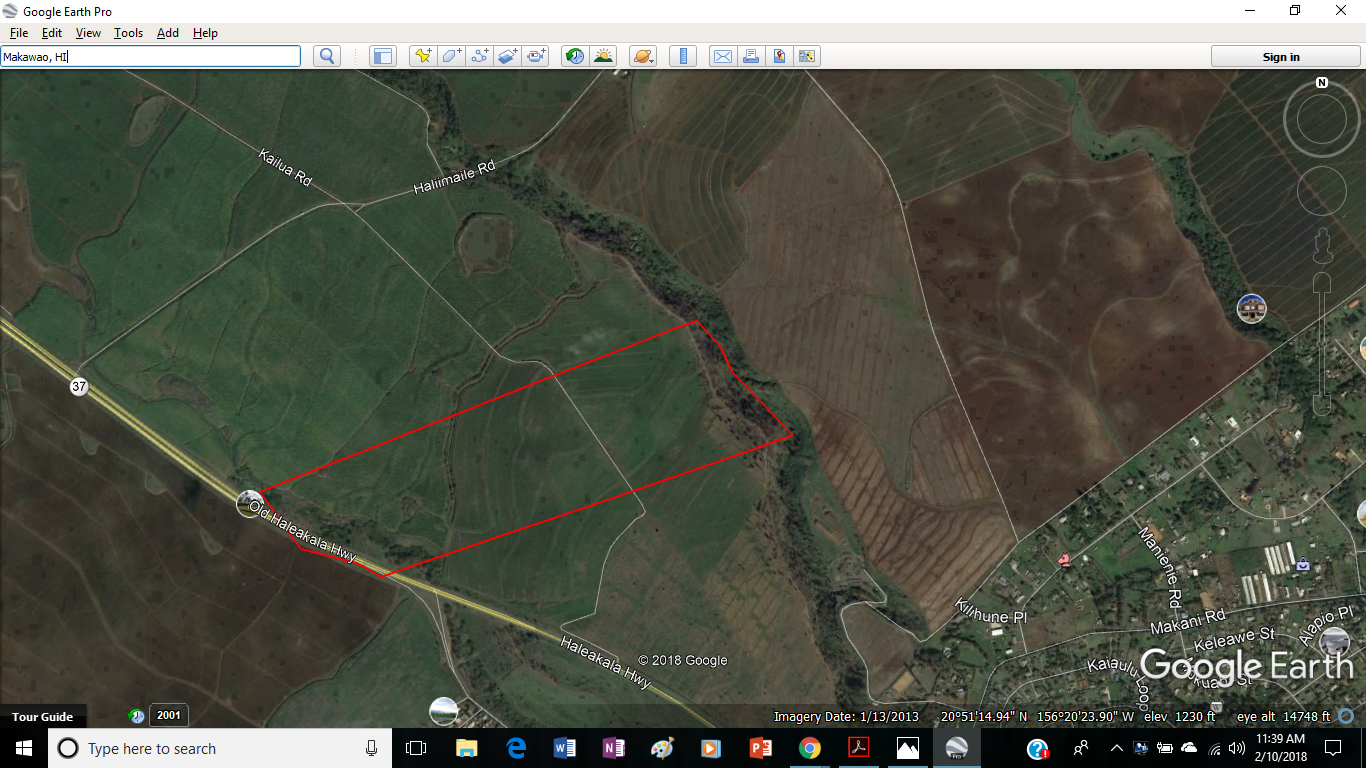
Land Grant 1672, 100 acres, (1855) TMK#: 225003021. It is owned today by Alexander & Baldwin Hawai'i Inc. Its purchased in 1927 by the Baldwins. Beginning in the late 1860's and early 1870's Alexander and Baldwin began buying up the land implicated in an "experiment" that was implemented by Kamehameha III, in which natives and naturalized foreigners were permitted to gain fee-simple interest in land (Polynesian, 1846). This was pre-mahele and considered ground breaking at the time.TB Cummings parcel was part of said area that extended from Hamakuapoko through Makawao and into parts of Pukalani and Kula.

LCA 249 (50 acres) granted to Kamanaulu (Kamanoulu), father of Kahale Cummings, in 1847 by Mahele, it is believed to have been sold at the death of Kamanoulu in 1877. Taken from the survey map Reg.0603 (wide) from 1872 by CJ Lyons. Full map can be found in the Hawaii State Archives digital collection. According to Hawaiian practice, all lands belonged to the ali`i, or chiefs. Bowing to pressure in 1845, King Kamehameha III announced an experiment whereby commoners could own land in Makawao. This first break in the feudal land system led three years later to the Great Mahele, a policy that established a private system of land ownership throughout the kingdom.
EIGHTEEN-SIXTIES
The decade produced the last two offspring between TB and Kahale. Parker was born sometime in 1860 and Hannah Rachel May 26, 1863. The first marriages of the second generation happened when WH Cummings married Kilauea Paiaulani on October 11, 1867. Then sometime in 1868-69 Caroline Cummings married Joaquin Dutro. It appears the family was still located at grant 1672 as the decade ended. As the contract with the Ministry of the Interior ended sometime in 1860, TB cummings is suspected of returning to teamster work with the transport of goods, as well as people, between Wailuku and Malaea/Lahaina. It it most likely that this became his lively hood for the next 20 years. He is listed in In 1880 as residing on Market Street in Wailuku and employed
EIGHTEEN-SEVENTIES
Marriages
- Sheldon-Cummings:On a Monday evening in Makawao, dated May 30, 1870, the Reverend H.H. Parker presided over the wedding of John G.M. Sheldon and Amy Ho'olai Cummings. The question that will always linger is if this was a pre-arranged marriage, considering the friendship between TB Cummings and Henry Sheldon.
- King-Cummings: Amorette Etta King married Thomas Both Cummings Jr, in 1875
- Jackson-Cummings: Miss Clarissa E.M. Jackson married William H. Cummings on October 5, 1877 at Makawao the Reverend J.S. Green presiding
- Miner-Cummings: Phoebe Poni Miner married Joseph E. Cummings on April 20, 1878, she the daughter of William Miner of Kaupo.
- Sheldon-Cummings: Hanna Rachael Cummings married, Henry Clay Sheldon on January 6, 1880 in Wailuku married the the Reverend H.H. Parker presiding.
Thomas Booth Cummings Work and Residence History 1880 to 1890
- 1880-1883: Teamster Express-man, Wailuku; residence 93 Market St. Wailuku (Husted, 1881)
**** Dock work Wailuku Harbor, Freight Handler
- 1884-1886: Kahalui-Naalehu Express Co, Kahalui; residence 18 Waihee Rd, Wailuku, (Husted, 1884)
**** Hauling freight between Kahalui/Wailuku and Maalaea
- 1887-1889: Freight agent for Steamships Maalaea and Drayman; residence Wailuku, (Husted, 1889)
**** Freight Agent securing freight contracts for Inter island steam ships
- 1890: Teamster; residence Wailuku, (Husted, 1890)
**** Probably not working at this point
References
(1880).The Hawaiian Kingdom Statistical and Commercial Directory and Tourist's Guide. Honolulu; San Francisco : George Bowser & Co. retrieved from. http://evols.library.manoa.hawaii.edu/handle/10524/19432
(1884). Husted's Directory of Honolulu and the Hawaiian Territory. Honolulu; San Francisco : George B & Co. Retrieved from. http://evols.library.manoa.hawaii.edu/handle/10524/12271
(1888). Husted's Directory of Honolulu and the Hawaiian Territory. Honolulu; San Francisco : George Bowser & Co. Retrieved from. http://evols.library.manoa.hawaii.edu/handle/10524/12272
(1889). Directory and Handbook of The Kingdom of Hawaii . Honolulu; San Francisco : George Bowser & Co. Retrieved from. Retrieved from. http://evols.library.manoa.hawaii.edu/handle/10524/12273
(1890). Directory and Handbook of the Kingdom of Hawaii. Honolulu; San Francisco : George Bowser & Co. Retrieved from. http://evols.library.manoa.hawaii.edu/handle/10524/19436
Ka Nupepa KuoKoa, (1877). The death of Kamanoulu, Honolulu, KOH Retrieved from. http://chroniclingamerica loc.gov/

The Decade of the Nineties
The last two records we have of Thomas Booth Cummings are 1) the 1890 Directory and Handbook of the Kingdom of Hawaii, in which he is listed as residing in Wailuku, Maui; Occupation Teamster. 2) Land Records Maui, Molokai, Lanai, and Kahoolawe, Grantee and Grantor Indices, 1845-1903. It is assumed that he did not work after 1890 and the Land records give no direct indication of a time of death. It does state that he died after 30 November 1893, that being the date that he executed a deed of sale to Clarissa Cummings (Cummings, 2008). This document does put him in Honolulu at that time, and it is my belief that he spent his last years in the home of WH and Clarissa in Kalihi. This makes it very possible that he might died on Oahu, rather than Maui.
Whether on Maui or Oahu, TB Cummings legacy was left in the upcountry regardless. He was probably about 70 years old and had spent about 50 years in his adopted homeland. Nurtured by a group of men that had long since departed, he was, along with George E. Miner the last of that breed of men that pioneered an agricultural change on East Maui.They were but a footnote in Hawaii's history, however, in the history of our ohana, they were of the utmost of importance. They provided the way for TB Cummings to gather an enormous resume of acquaintances. When you consider that this seemingly quiet wrangler from Makawao knew, and not only by acquaintance, but by friendship as well, Henry Lawrence Sheldon, important, adviser to Kamehameha III, and editor of several newspapers, William Humphreys, Secretary to the Hawaiian Supreme Court and Hawaiian Patriot in his support, guidance and inspiration towards the citizens of Kalawao laden with Hansen's disease, Edwin Miner, Lahaina District Justice, John Meeks, Captain of Kamehameha I’s sloop, John Dominus the husband of Queen Liliuokalani, William Henry Daniels, Circuit Court Judge Honolulu and Representative in the legislature, Lot Kapuaiwa Minister of the Interior and future Kamehameha V, and J S Green, the most influential Pastor in East Maui. That is success measured by a different yardstick.
The five decades Thomas Cummings spent on Maui were ones that saw cultural, economic and social change to a degree that was never before seen. Less than 120 years had passed since the re-discovery by Cook in 1778. In those pre-Cook years the agricultural labor in the islands was not onerous, in respect to the standards of today. According to Wienman, (1934).”The Maka’ainana were forced to labor 6 days for every fortnight for the King and Konohiki. However in this feudal society without money or commerce, certain limits were set on accumulation of wealth, and hence, on exploitation. Production was largely for consumption. It is true that the King and the nobility consumed disproportionately, but even the royal stomach had a circumscribed capacity" (p. 4). But steadily after 1850 the capitalist mode began to kick in and effect the Hawaiian people in more intensified ways. This, directly due to the success of the sugar industry which continued its march towards a two crop society of Sugar and Pineapple.
In the last decade of the 19th century, Thomas Booth Cummings and George Miner were the only ones left from that era. However, the annals of time will consider Thomas Cummings the settler and George Miner the native born. Regardless, they both were the last testimony to a bygone era, that was but a footnote in Hawaii's history, yet a defining chapter in the history of our ohana. So as the news came over the Evold wire service about the passing of W.H.Cummings passing in Japan on a July day in 1900, part of the description of W.H.Cummings life was that his father was one of the oldest white settlers in Makawao.
References
(1890). Directory and Handbook of the Kingdom of Hawaii. Honolulu; San Francisco : George Bowser & Co. Retrieved from. http://evols.library.manoa.hawaii.edu/handle/10524/19436
Cummings, D. (2008). The Cummings Papers, sub-group 10, The ancestry of Thomas Booth Cummings, The Ne Bedford Research Library. New Bedford, Ma.
Wienman, S. (1934). Hawaii : A story of imperialist plunder. Retrieved from.http://babel.hathitrust.org/cgi/pt?id=mdp.39015073497854;view=1up;seq=1